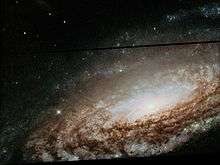NGC 7331
| NGC 7331 | |
|---|---|
|
Taken by Vicent Peris using the 3.5 meter telescope at the Calar Alto Observatory in southern Spain. | |
| Observation data (J2000 epoch) | |
| Constellation | Pegasus |
| Right ascension | 22h 37m 04.1s[1] |
| Declination | +34° 24′ 56″[1] |
| Redshift | 816 ± 1 km/s[1] |
| Distance | 40 ± 3 e6ly (12.2 ± 1.0 Mpc)[2] |
| Apparent magnitude (V) | +10.4[1] |
| Characteristics | |
| Type | SA(s)b[1] |
| Apparent size (V) | 10′.5 × 3′.7[1] |
| Other designations | |
| UGC 12113, PGC 69327,[1] Caldwell 30 | |
NGC 7331 (also known as Caldwell 30) is a unbarred spiral galaxy about 40 million light-years (12 Mpc) away in the constellation Pegasus. It was discovered by William Herschel in 1784.[3] NGC 7331 is the brightest member of the NGC 7331 Group of galaxies. The other members of the group are the lenticular or unbarred spirals NGC 7335 and 7336, the barred spiral galaxy NGC 7337 and the elliptical galaxy NGC 7340. These galaxies lie at distances of approximately 332, 365, 348 and 294 million light years, respectively. [4] In both visible light and infrared photos of the NGC 7331, the core of the galaxy appears to be slightly off-center, with one side of the disk appearing to extend further away from the core than the opposite side.
The galaxy is similar in size and structure to the Milky Way, and is often referred to as "the Milky Way's twin".[5] However, discoveries in the 2000s regarding the structure of the Milky Way may call this similarity into doubt, particularly because the latter is now believed to be a barred spiral, compared to the unbarred status of NGC 7331.[6]


Retrograde bulge
In spiral galaxies the central bulge typically co-rotates with the disk but the bulge in the galaxy NGC 7331 is rotating in the opposite direction to the rest of the disk.[7]

Supernova
.jpg)
SN 1959D, a Type IIL supernova,[8] was the first supernova identified within NGC 7331.[1] The supernova was discovered by Milton Humason and H. S. Gates in a survey at Palomar Observatory.[9]
More recent supernovae are SN 2013bu and SN 2014C that latter of which underwent an interesting "metamorphosis". [10]
See also
- M94 – another galaxy with a prominent starburst ring
- NGC 1512 – another galaxy with a prominent starburst ring
References
- 1 2 3 4 5 6 7 8 "NASA/IPAC Extragalactic Database". Results for NGC 7331. Retrieved 2006-11-10.
- ↑ Jensen, Joseph B.; Tonry, John L.; Barris, Brian J.; Thompson, Rodger I.; et al. (February 2003). "Measuring Distances and Probing the Unresolved Stellar Populations of Galaxies Using Infrared Surface Brightness Fluctuations". Astrophysical Journal. 583 (2): 712–726. Bibcode:2003ApJ...583..712J. arXiv:astro-ph/0210129
 . doi:10.1086/345430.
. doi:10.1086/345430. - ↑ The NGC/IC Project : NGC Discoverers List by Bob Erdmann.
- ↑ "Spiral Galaxy NGC 7331, Galaxy Group (NGC 7335, 7336, 7337)".
- ↑ "Seeing Double: Spitzer Captures Our Galaxy's Twin". Spitzer Space Telescope Newsroom. Spitzer Science Center. 2004-06-28. Archived from the original on May 17, 2007. Retrieved 2008-04-24.
- ↑ "The Milky Way Has Only Two Spiral Arms". 2008-06-03. Retrieved 2008-06-04.
- ↑ A Counter-rotating Bulge in the Sb Galaxy NGC 7331 , F. Prada, C. Gutierrez, R.F. Peletier, C.D. McKeith, the Astrophysical Journal, 463 :L9–L12, 20/5/1996
- ↑ "NASA/IPAC Extragalactic Database". Results for SN 1959D. Retrieved 2006-11-10.
- ↑ M. L. Humason; H. S. Gates (1960). "The 1959 Palomar Supernova Search". Publications of the Astronomical Society of the Pacific. 72: 208–209. Bibcode:1960PASP...72..208H. doi:10.1086/127513.
- ↑ D. Milisavljevic; et al. (2015). "Metamorphosis of SN 2014C: Delayed Interaction Between a Hydrogen Poor Core-collapse Supernova and a Nearby Circumstellar Shell".
External links
- Calar Alto Observatory – NGC 7331
- APOD (2004-07-01) – "A Galaxy So Inclined"
- SST – "Morphology of Our Galaxy's 'Twin'"
- NGC 7331 at the astro-photography site of Mr. T. Yoshida
- NGC7331 at W. Kloehr Astrophotography
- NGC 7331 on WikiSky: DSS2, SDSS, GALEX, IRAS, Hydrogen α, X-Ray, Astrophoto, Sky Map, Articles and images
Coordinates: ![]() 22h 37m 04.1s, +34° 24′ 56″
22h 37m 04.1s, +34° 24′ 56″
